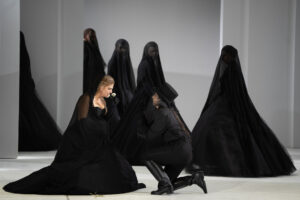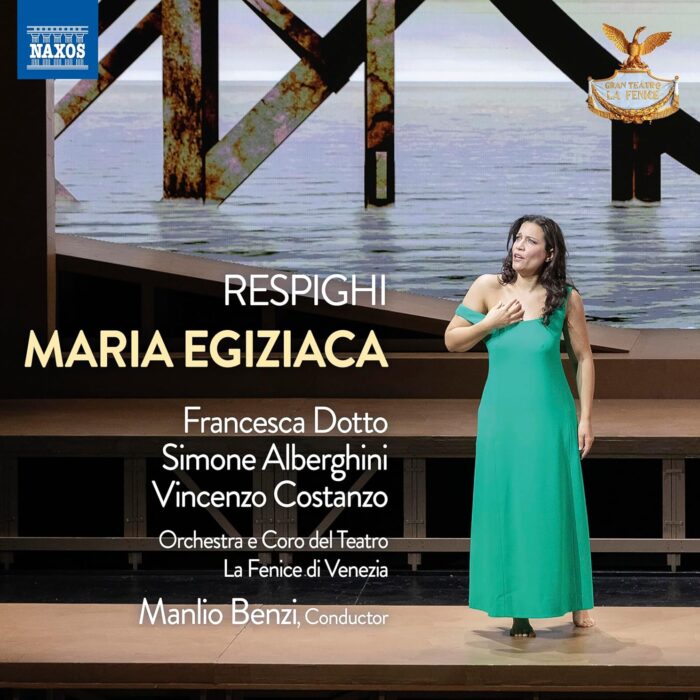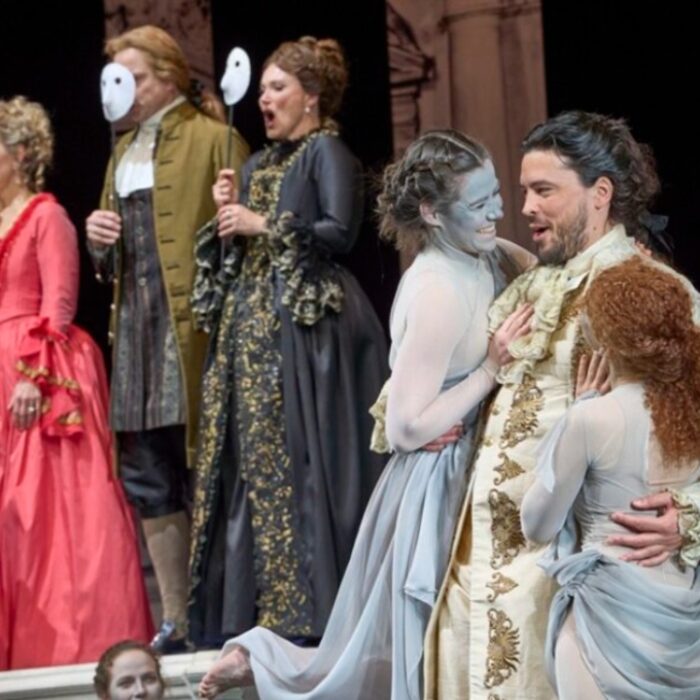
Festival Valle d’Itria Festival 2024 Review: Ariodante
Cecilia Molinari Steals the Limelight as Ariodante
By Alan Neilson(Photo: Clarissa Lapolla)
As the last notes of Ariodante’s aria “Dopo notte atra e funestra” died away, the audience sounded its approval with enthusiastic applause and loud cheering; some people were even on their feet. They were joined by the orchestra and its conductor, Federico Maria Sardelli, who was also applauding. And it showed no signs of abating, at least not until Sardelli lifted his baton to encore the da capo, after which there was more cheering.
It was, literally, a show stopping performance from the Italian mezzo-soprano, Cecilia Molinari. What made it so special was not her technique or interpretation, both of which were excellent, but that magical ingredient that has the power to lift the audience to a higher plane. The sheer joy that she was able to convey as she trotted out note-perfect, complex coloraturas and roulades, while entrancing with her enchanting, almost dance-like movement, was captivating. She was fully immersed in her character; all self-awareness was seemingly absent, and she carried the audience with her.
Nor was it a one-off rendition that came from out of the blue. Rather, it emerged from a scintillating performance that even during the sinfonia had the audience entranced as, dressed in black formal attire with a top hat and carrying a large olive branch, she moved around the stage with a confidence and presence that immediately caught the attention.
Each of her arias was crafted to bring out their full emotional content, such as in her carefree, playful rendering of “Qui d’amour,” in which she caught the spirit of a man in love, or in her rendition of Ariodante’s aria “Tu preparati a morire,” in which her sensitive moulding of the vocal line captured his desperation, anger and disbelief simultaneously.
While she did not hold back her anger as she spat her words in the arioso “Numi lasciami vivere,” her rendition of “Con l’ali di costanza” was a no-holes-barred celebration of Ariodante’s good fortune and love for Ginevra, in which she dazzled the audience with her rapid, complex series of coloratura displays, underpinned by a voice filled with unbridled joy. It was a stunning performance that received loud, sustained applause from the audience.
Rather than performing the opera in three distinct acts, Sardelli decided to divide it into two parts, ending the first part with the aria “Scherza infida,” which allowed Molinari to show off her ability to sensitively portray Ariodante’s sense of betrayal and heartfelt pain through her gentle yet anguished ornamentations and carefully placed colorful inflections while struggling to free himself from Ginevra’s wedding veil. The curtain had barely closed before Sardelli raced from the pit to ensure that Molinari returned to receive the audience’s acclamation.
Brilliant as Molinari’s performance may have been, it was only one element in what was an excellent production, in which the staging and the music combined superbly to create a mesmerizing theatrical experience.
Excellent Musical Performances
The musical side of the production was under the direction of Sardelli, who used a new edition by Bernardo Ticci, based on the autographed score held by the British Museum, to celebrate the festival’s 50th year. Notable changes included the removal of the dance numbers, the use of female instead of falsetto voices, and the removal of the theorbo from the basso continuo.
Eliciting a brisk pace from the Orchestra Barocca Modo Antiqua, Sardelli created a dramatic reading with plenty of vitality and rhythmic energy, although he knew exactly when to slow things down to build the emotional tensions and highlight the contrasting moods. The sound was cleanly articulated and nicely balanced, and the relationship with the singers, despite occasional coordination problems due to the quick tempi, was well managed, and allowed them to flourish.
Contralto Teresa Iervolino created a fascinating portrait of the evil Polinesse, who, at times, looked and behaved like the Joker from Todd Phillips’ film. With her face painted in black and white, she smiled, laughed and raged as she abused Dalinda and others. She swiftly moved between apparent friendliness and violence; her facial expressions were wonderfully animated; and her behavior was always unpredictable. Her Polinesse was a psychopath, dressed up for the movies, which she illustrated perfectly in the aria “Dover, giustizia, amor,” as he looked forward to his duel with Lurcanio. Attacking the line with faux heroic sentiments, she swaggered about the stage, singing with a carefree confidence, complete with detailed embellishments, in what was an expressively strong performance.
During the first part of the performance, soprano Francesca Lombardi Mazzulli, playing the role of Ginevra, appeared somewhat anxious about Sardelli’s brisk tempi and was repeatedly glancing towards the pit. Certainly, there was a degree of inexactitude in her singing, but it did not prevent her from delivering an expressively compelling performance. After the interval, she seemed a lot more at ease and sang with more confidence and greater freedom, which she illustrated in her agile, expressively satisfying rendition of “Sì, morrò; ma l’onor mio,” which she performed incognito, dressed in black sunglasses and a raincoat, while appearing to have temporarily lost her reason.
With four sparking arias, Dalinda is a splendid role for sopranos to display their vocal talents, and the wonderful Greek Cypriot Theodora Raftis did not disappoint with a vibrant performance, in which she not only brought her character thrillingly to life but sang with such freedom, agility and brio that each aria was a musical delight. Together, they showed off the breadth of her admirable technique to good effect as she furnished the vocal line with an impressive array of detailed embellishments, indulged in complex coloratura runs, and added nicely placed emphases and dynamic inflections, which came together most spectacularly in “Neghittosi or voi che fate?” in which she rages at Polinesse’s treachery. Yet, they were not superficial shows; rather, they were thoughtfully moulded to fit the dramatic context.
The bass Biagio Pizzuti made a fine impression as The King of Scotland, whom he depicted as a strong, authoritative and fair-minded ruler, if, on occasion, lacking the necessary insight and judgement where his daughter was concerned. His attention to and articulation of the text, allied to the clarity of his singing, ensured that the recitatives were particularly well-formed and nuanced. Likewise, his arias were neatly rendered with a pleasing tendency towards understatement that ensured his dignity was maintained throughout.
Tenor Manuel Amati has a warm, inviting voice with the ability to capture the full beauty of a melody, and although he can at times glide through a scene without exploiting the dramatic nuances of the situation, his singing is always pleasing on the ear. As Lurcanio, it was a similar situation. His opening aria, “Del mio sol vezzosi rai,” in which he declared his love for Dalinda, was beautifully sung, and captured Lurcanio’s passionate feelings, while his aria, “Il tuo sangue, ed il tuo zelo,” displayed a more forceful side to the character, and although he could have embellished the vocal line with more finesse, his vocal beauty again stood out.
The cast was completed by tenor Manuel Caputo in the relatively small role of Odoardo, for which he produced a pleasingly sung and clearly defined performance.
Fischer’s Black & White Staging
The director, Torsten Fischer, rightly ignored the fact that “Ariodante” is set in mediaeval Scotland on the grounds that the narrative has no connection with it whatsoever; instead, he harked back to its original source, Ariosto’s “Orlando Furioso,” and cut straight to the heart of the drama. “Ariodante” is about love, about its fickleness, its ability to deceive, its power to betray and enslave, to transport people to a heavenly state or send them into the depths of Hell. It is connected to power and to lust and can manifest itself in various forms, whether between lovers, father and daughter, or brothers. It is a driver that propels human behaviour to its extremes, even to madness, regardless of the consequences. And this became the unambiguous focus of Fischer’s presentation.
Aided by scenographer Herbert Schäfer and costume designer Vasilis Triantafillopoulos, Fischer opted for a highly stylized staging, in which a naturalistic setting was rejected in favor of a suggestive, semi-surreal presentation with a fascinating, consistent aesthetic, which worked superbly. The male characters wore formal black suits, white waistcoats, and bow ties, which Ariodante added to with a top hat and black boots, while the female characters generally wore black gowns. The staging consisted of simple, white, rectangular frames positioned within each other to create perspective. Everything was colored either black or white. A video projection of a pale full moon, suggesting the madness that gripped the characters, as well as, no doubt, a reference to “Orlando Furioso,” was the only real notable addition to the set.
The movements of the singers were imaginatively fashioned. They were not always explicitly connected to the action, but they never seemed out of place and always hinted at something that was generally understood. For example, when the King sang his aria “Voli co’ la sua tromba,” he was surrounded by the cast, who mimicked his every movement.
Overall, the production was a success on all fronts; Fischer’s imaginative and aesthetically pleasing staging sat perfectly alongside Sardelli’s musical reading, and together they provided an excellent platform for Molinari to excel.



